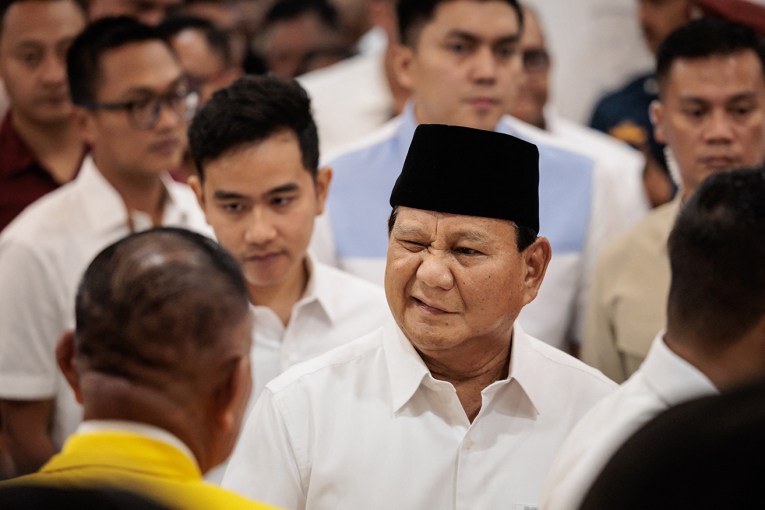Court-packing and abortion silence: Republicans attempt Supreme rule for a generation

President Donald Trump’s Supreme Court nominee has refused to reveal her stance on abortion ahead of two landmark cases establishing pregnant women’s rights.
During the second day of confirmation hearings, Judge Amy Coney Barrett fielded questions from Democratic Senator Dianne Feinstein on whether she agreed with a previous Supreme Court decision to protect a pregnant woman’s right to have an abortion.
A devout Catholic, Judge Barrett said she would separate her private religious beliefs from any judicial rulings she will make but declined to specifically answer questions about abortion.
She argued it would be improper for a nominee to say in advance how they would decide on cases before the court.
“I have a life brimming with people who have made different choices and I have never tried in my personal life to impose my choices on them, and the same is true professionally,” Judge Barrett told the Senate Judiciary Committee.
“I am committed to the rule of law.
Courts have a vital responsibility to enforce the rule of law…but courts are not designed to solve every problem or right every wrong in our public life.’’
Judge Barrett’s faith and openness to overturning rulings if she believes they do not reflect the law as it is written has made Democrats and women’s rights activists seriously worried.
If the Republicans succeed in fast-tracking Judge Barrett to the Supreme Court, the power to decide the future of the Roe v Wade abortion rule will tip heavily in their favour.
Pro-choice advocates argue that if abortion is made a crime, women will resort to desperate measures like underground abortions, risking their health and safety.
Personal decisions around women’s reproductive health, they argue, should lie in the hands of women – not the government.
On the other side, anti-abortion campaigners – especially evangelicals – believe life begins the moment a man’s sperm fertilises a woman’s egg.
By this logic, they see all abortions as an act of murder.
Enter Donald Trump, a president who has been married three times and faces multiple accusations of cheating, sexual assault and harassment.
Despite his scandalous history, Mr Trump has managed to win over a powerful conservative voter base steeped in religion.
This explains why he has nominated Judge Barrett as his pick for a lifetime place on the Supreme Court.

If Judge Amy Coney Barrett becomes a Supreme Court Justice, conservatives will have a 6-3 majority, compared to a 5-4 split with progressives. Photo: TND
What does ‘court-packing’ mean?
‘Court-packing’ is when a political party adds – or ‘packs’ – more justices onto the Supreme Court to secure the desired majority.
Both the Republicans and Democrats prefer to have more justices from their party on the court so the balance of power is in their favour.
That way, it’s easier for them to obtain the rulings they want.
The idea of ‘court packing’ is nothing new, but has become the centre of a heated debate since the death of progressive icon Justice Ruth Bader Ginsburg, and the Senate confirmation hearing for Judge Barrett, a staunch conservative.

Ruth Bader Ginsburg was laid to rest in September after dying from cancer. Photo: Getty
Immediately after Justice Ginsburg died, US President Donald Trump and Senate Republicans started rushing to get Judge Barrett confirmed before election day so they could lock in a 6-3 conservative majority on the court.
The move has outraged Democrats, who argue that it’s unfair of the Republicans to fast-track a justice to the Supreme Court in the middle of an election.
It’s not unprecedented
The concept of ‘court packing’ was introduced by President Franklin D Roosevelt in 1937.
The former Democrat president was sick of the US Supreme Court striking down several New Deal laws aimed at boosting recovery from the Great Depression.
To get around this, he proposed adding up to six justices – expanding the court from nine to as many as 15 – with a new justice added for each sitting justice older than 70 who refused to retire.
The plan was widely criticised as undermining the government’s separation of powers, even by fellow Democrats, and Mr Roosevelt failed to get his way.
Today, there remain nine justices on the court, but that could change.
Nothing in the Constitution says there can only be nine.
Congress can change the number by passing an act that is then signed by the president.

Pro-choice and anti-abortion activists rally in front of the the US Supreme Court during this year’s 47th annual March for Life to mark the anniversary of the Supreme Court Roe v Wade ruling. Photo: Getty
What’s Roe v Wade and why is everyone talking about it?
Roe v Wade is a landmark Supreme Court ruling in 1973 that effectively legalised abortion across the US.
It followed several legal challenges by Texas mother of two, Norma McCorvey, who wanted an abortion but was blocked by the state’s laws that ruled a woman could only get an abortion if her life was in danger.
To protect her identity during the legal proceedings, Ms McCorvey was known by the legal pseudonym “Jane Roe”, but later went public.
Henry Wade, the opposing Dallas County attorney-general, gave his name to the case, hence the title Roe v Wade.
After a series of decisions and appeals, Ms McCorvey’s case reached the US Supreme Court, which ruled in 1973 that the Texas law was unconstitutional by a 7-2 majority.
Although there is no mention of abortion in the Constitution, the justices reasoned that a right to privacy extended to a right to have an abortion.
And so began the start of a bitter, highly politicised and emotional debate that continues in the US today.








